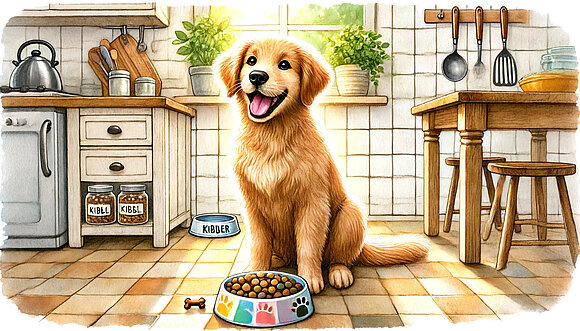Basics: Everything you need to know about dry dog food

What is dry food?
Dry food, often called kibble, is a type of dog food that comes in a dried form. It consists of a mixture of ingredients that are dried and formed into small, crunchy pieces. This type of food has a long shelf life and is easy to store, making it a popular choice for many dog owners.
The production of dry food
The process of making kibble begins with the selection of ingredients. These can include meat, grains, vegetables, vitamins and minerals. The ingredients are ground, mixed and then cooked. The cooking process makes the nutrients more digestible. The cooked mixture is then pressed into the desired shape and dried.
Advantages of dry food
Practical storage and handling
One of the biggest advantages of dry food is its long shelf life. It can be bought and stored in large quantities without spoiling quickly. It is also easy to portion and clean to handle without having to worry about unpleasant odors or contamination.
Dental health
The crunchy texture of the dry food can help to clean your dog's teeth. Chewing removes plaque, which reduces the formation of tartar and promotes oral hygiene.
Balanced diet
Good dry food is formulated to contain all the necessary nutrients your dog needs. It provides a balanced mix of proteins, fats, carbohydrates, vitamins and minerals.
What should you look for when buying dry food?
Ingredients
A look at the ingredients list is crucial. High-quality dry food should contain meat or fish as the main ingredient. Look out for specific details such as "chicken meat" instead of "meat meal". Avoid food with lots of artificial additives, colorings or preservatives.
Nutrient content
The nutritional content should meet your dog's needs. Puppies, adult dogs and senior dogs have different nutritional requirements. There is special food for every stage of life and also for special needs such as allergies or obesity.
Compatibility and taste
Not every dry food is equally well tolerated by every dog. Observe how your dog reacts to a new food. Pay attention to his digestion, coat and general vitality. Of course, the food should also taste good, because what good is the best food if your dog doesn't like it?
Can you mix dry food with wet food?
A few years ago it was thought...
A few years ago, it was thought that this type of diet was not good for dogs. Even today, the argument still circulates on the Internet that different ingredients in the food are digested at different rates and that mixed feeding is therefore unhealthy. However, it is now known that a varied diet does not necessarily lead to digestive problems. It is relatively easy to tell whether your dog is tolerating the mixed diet well: Are his droppings normal, is his coat shiny, is he not vomiting and does he seem fit all round?
Advantages of mixing
Yes, you can mix dry and wet food! This combination offers several advantages:
- Variety of flavors: some dogs are picky and like variety. Mixing can help to make the food more interesting.
- Moisturization: Wet food has a high water content, which can be especially helpful for dogs that don't drink much.
- Texture: The mix of crunchy and soft textures can be particularly appealing to your dog.
Mixing tips
However, there are a few points to bear in mind when mixing:
- Portion size: be sure to calculate the total amount of food to avoid overfeeding.
- Transition period: If your dog is not used to the mixed food, introduce it slowly to avoid digestive problems.
- Quality: Choose both high quality dry and wet food to ensure your dog receives a balanced diet.
Possible disadvantages
There are also some potential disadvantages:
- Cost: Wet food is often more expensive than dry food, so the overall cost may increase.
- Tooth cleaning: The teeth-cleaning effect of dry food can be somewhat reduced by mixing it with wet food.
Feeding dry food correctly
Portion sizes
The right amount of dry food depends on several factors, such as your dog's age, weight, activity level and state of health. You will usually find feeding recommendations on the packaging that can serve as a guideline.
Water intake
As dry food contains little moisture, it is important that your dog always has access to fresh water. Adequate water intake is essential for your dog's health, especially if it is mainly fed dry food.
Feeding times
Regular feeding times help to stabilize your dog's digestive rhythm. Depending on age and requirements, you can divide the daily ration into two or more meals.
Dry food as part of a balanced diet
Dry food can be an excellent choice for your dog's diet, provided you pay attention to quality and the individual needs of your four-legged friend. Armed with the right information, you can make the best decision and keep your dog healthy and happy.